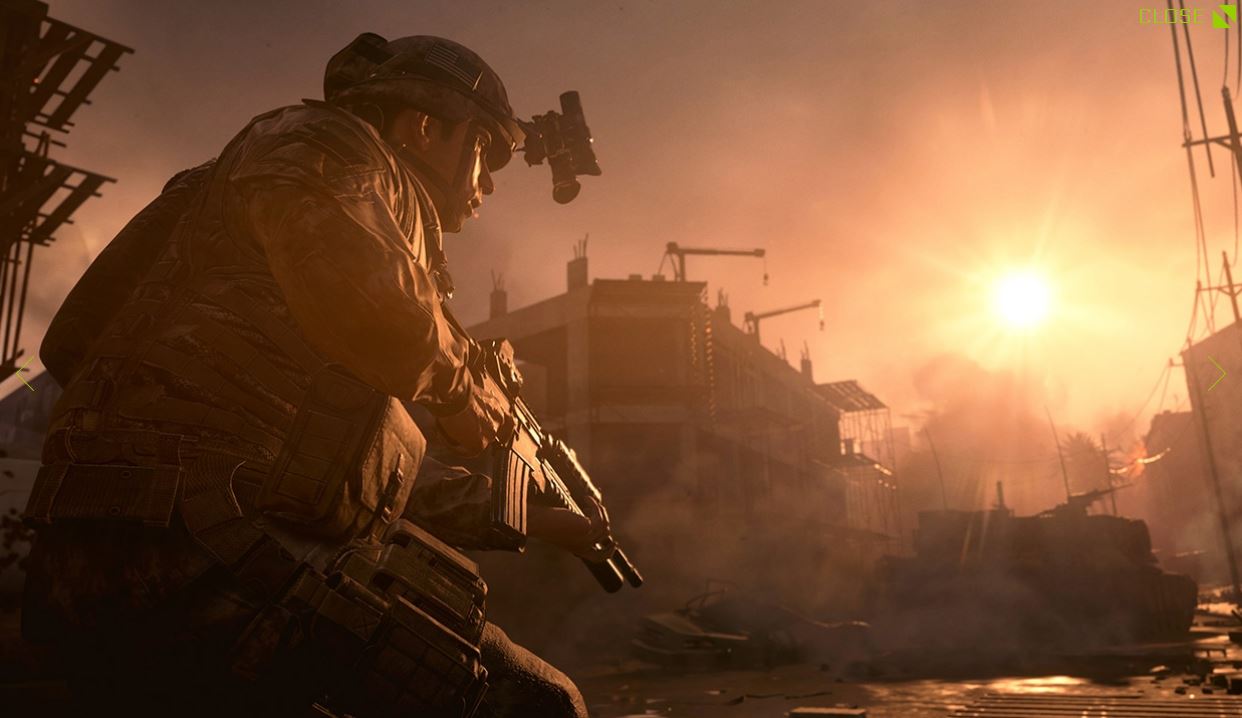Call of Duty is one of the most popular first-person shooter video game franchises in the world. Since its inception in 2003, the game has been a staple of the gaming industry, with millions of players around the globe. Over the years, the game has evolved and adapted to new technologies, and now, with the advent of virtual reality, Call of Duty has taken on a whole new level of immersion.
With the release of VR headsets like the Oculus Quest 2 and PlayStation VR, players can now experience the intensity of Call of Duty in a whole new way. The VR versions of the game allow players to step into the boots of soldiers on the front lines of battle, with realistic graphics and immersive sound effects. Players can use their VR controllers to aim and shoot, duck behind cover, and even throw grenades, all with a level of precision and realism that was previously impossible in traditional gaming.
While the use of VR in Call of Duty is still relatively new, it has already garnered a lot of attention from gamers and industry experts alike. Many see it as the future of gaming, with the potential to revolutionize the way we play and experience video games. As the technology continues to evolve and improve, it’s likely that we’ll see even more incredible VR experiences in the world of Call of Duty and beyond.
The Concept of Call of Duty VR
Virtual Reality in Gaming
Virtual Reality (VR) has been a buzzword in the gaming industry for a while now. It is a technology that allows players to immerse themselves in a virtual world and experience it as if it were real. With the advancement of technology, VR has become more accessible and affordable, making it an attractive option for game developers.
The use of VR in gaming has opened up new possibilities for game developers to create immersive experiences that were not possible before. Players can now interact with the game environment in a way that was not possible with traditional gaming. This has led to the development of new game genres and experiences.
Call of Duty Franchise
Call of Duty is one of the most popular first-person shooter franchises in the gaming industry. The franchise has been around for over a decade and has a massive fan base. The game has always been known for its fast-paced action and realistic graphics.
The franchise has experimented with different game modes and settings over the years, from modern warfare to space combat. With the introduction of VR, the franchise has the potential to take the gaming experience to the next level.
The use of VR in Call of Duty can provide players with a more immersive experience. Players can feel like they are in the game environment and experience the action as if it were real. This can add a new level of excitement and intensity to the gameplay.
In conclusion, the use of VR in gaming has opened up new possibilities for game developers to create immersive experiences. The Call of Duty franchise has the potential to take advantage of this technology and provide players with a more immersive experience.
Gameplay and Mechanics
Player Experience
Call of Duty VR offers an immersive gameplay experience that puts players in the middle of the action. The game features a range of game modes, including single-player campaigns, co-op missions, and multiplayer matches, which allows players to choose the type of experience they prefer. The game’s graphics and sound design are top-notch, providing players with a realistic and engaging environment to explore.
One of the key features of Call of Duty VR is its intuitive control system, which allows players to move around, aim, and shoot with ease. Players can use a variety of weapons and gadgets, including grenades, flashbangs, and drones, to take down enemies and complete objectives. The game also includes a range of customization options, allowing players to tailor their loadouts to suit their playstyle.
Combat System
The combat system in Call of Duty VR is fast-paced and intense, requiring players to think on their feet and react quickly to changing situations. The game’s AI opponents are challenging and varied, forcing players to adapt their tactics and strategies to succeed. The game also includes a range of vehicles, such as helicopters and tanks, which players can use to gain an advantage in battle.
In addition to traditional combat, Call of Duty VR also features a range of special abilities and perks that players can use to gain an edge. These include things like enhanced speed and agility, increased damage resistance, and improved accuracy. Players can earn these abilities by completing objectives and earning experience points, which can be used to level up their character and unlock new gear.
Overall, Call of Duty VR offers an engaging and immersive gameplay experience that is sure to delight fans of the franchise. With its intuitive controls, challenging combat, and range of customization options, the game is a must-play for anyone looking for an exciting VR shooter.
Technical Aspects
Hardware Requirements
To play Call of Duty in VR, one needs a VR headset and a powerful PC that meets the minimum hardware requirements. The VR headset must have motion controllers and be compatible with SteamVR. The minimum hardware requirements for playing Call of Duty in VR are:
- Processor: Intel Core i5-6600K or AMD Ryzen 5 1400
- Memory: 8 GB RAM
- Graphics: NVIDIA GeForce GTX 970 or AMD Radeon R9 390
- Storage: 175 GB available space
It is important to note that these are the minimum requirements, and for a better experience, it is recommended to have a more powerful PC with higher specifications.
Software Compatibility
To play Call of Duty in VR, one needs to have the game and the VR software installed on their PC. Call of Duty can be purchased on Steam, and it is compatible with SteamVR. The VR headset must also be compatible with SteamVR.
It is important to note that not all VR headsets are compatible with Call of Duty. The game has been tested and optimized for Oculus Rift, HTC Vive, and Windows Mixed Reality headsets. It may work with other VR headsets, but the experience may not be optimal.
In conclusion, playing Call of Duty in VR requires a powerful PC that meets the minimum hardware requirements and a compatible VR headset with motion controllers. The game can be purchased on Steam and is compatible with SteamVR. It is important to have a VR headset that has been tested and optimized for Call of Duty to have the best experience.
Multiplayer Mode
Call of Duty VR offers players an immersive multiplayer experience. The game features two main multiplayer modes: Co-Op Missions and Player versus Player.
Co-Op Missions
In Co-Op Missions, players team up to complete objectives in a cooperative gameplay setting. These missions are designed to be challenging and require teamwork to complete successfully. Players can choose from a variety of missions, each with its own unique objectives and challenges. Some missions require players to defend a location, while others require players to extract hostages or eliminate enemy targets. Co-Op Missions can be played with up to four players.
Player versus Player
In Player versus Player mode, players compete against each other in various game modes. These modes include classic Call of Duty game modes such as Team Deathmatch and Domination, as well as new modes designed specifically for VR. Players can choose from a variety of loadouts and customize their weapons and equipment to suit their playstyle. The game also features a ranking system, allowing players to earn rewards and climb the leaderboards.
Overall, Call of Duty VR’s multiplayer mode offers an engaging and immersive experience for players looking to compete or cooperate with others. With a variety of game modes and missions, players can enjoy hours of intense gameplay.
Game Development
Development Process
Call of Duty VR was developed by Activision Blizzard, one of the leading video game companies in the world. The development process for the game involved a team of experienced game developers and designers who worked tirelessly to create a game that would provide players with an immersive and exciting experience.
The development process for Call of Duty VR involved several stages, including pre-production, production, and post-production. During the pre-production stage, the team worked on developing the concept for the game, creating storylines, and designing the game mechanics.
In the production stage, the team worked on creating the game assets, including 3D models, textures, and animations. They also worked on coding the game mechanics and creating the game levels.
Finally, in the post-production stage, the team worked on polishing the game, fixing bugs, and optimizing the game for different platforms.
Behind the Scenes
The development of Call of Duty VR involved several challenges, including creating a game that would work well in virtual reality. The team had to find ways to optimize the game for VR, including designing the game levels to minimize motion sickness.
The team also had to find ways to make the game feel immersive and realistic, including creating realistic sound effects and designing the game environments with a high level of detail.
In addition to these challenges, the team also had to work within a tight development schedule. Despite these challenges, the team was able to create a game that has received positive reviews from players and critics alike.
Overall, the development of Call of Duty VR was a complex and challenging process that required a high level of skill and expertise. The team was able to overcome these challenges and create a game that provides players with an immersive and exciting experience.
Critical Reception
Call of Duty VR has received mixed reviews from both players and professionals. Here is a breakdown of the critical reception:
Player Reviews
Many players have praised the immersive experience of playing Call of Duty in VR. The ability to physically move and aim in the game has been described as a game-changer by some. However, there have also been complaints about motion sickness and the limited gameplay options.
Professional Critiques
Professional critics have also had mixed opinions on Call of Duty VR. Some have praised the game for its innovation and potential for the future of gaming. Others have criticized the game for its limited content and lack of replayability.
Overall, while Call of Duty VR has received some positive feedback for its immersive experience, it has also faced criticism for its limited gameplay options and lack of content. As VR technology continues to improve, it will be interesting to see how developers will push the boundaries of what is possible in VR gaming.
Future of Call of Duty in VR
Call of Duty has been a popular first-person shooter game for years, and now with the emergence of virtual reality, the game has the potential to become even more immersive. While there have been a few VR adaptations of the game in the past, there is still a lot of room for growth and development in this area.
One of the main challenges facing Call of Duty in VR is the issue of motion sickness. Players can experience discomfort or nausea when moving quickly in a virtual environment. However, some developers have been experimenting with different movement mechanics, such as teleportation or smooth locomotion, to try and alleviate this issue.
Another challenge is adapting the game’s fast-paced gameplay to VR. It can be difficult to aim and maneuver quickly in a virtual environment, which can impact the overall experience of the game. However, with the use of motion controllers and other VR technology, players can have more control and precision in their movements.
Despite these challenges, the future of Call of Duty in VR looks promising. With the continued advancements in VR technology, it’s possible that we could see a fully immersive Call of Duty experience in the near future. This could include features such as realistic weapon handling, interactive environments, and even multiplayer modes.
Overall, while there are still some obstacles to overcome, the potential for Call of Duty in VR is exciting. As more developers explore this area, we can expect to see some innovative and immersive adaptations of the game in the years to come.
Frequently Asked Questions
What platforms support Call of Duty VR?
Call of Duty VR is currently available on the Oculus Rift and HTC Vive platforms. It is not yet available on PlayStation VR.
Is Call of Duty: Infinite Warfare VR compatible?
No, Call of Duty: Infinite Warfare does not have a VR mode. However, the standalone Call of Duty VR game is available on the Oculus Rift and HTC Vive platforms.
Will there be a Call of Duty VR game?
It is uncertain if there will be a new Call of Duty VR game. However, the standalone Call of Duty VR game is available on the Oculus Rift and HTC Vive platforms.
Are there any Call of Duty VR zombies games?
No, there are currently no Call of Duty VR zombies games. However, the standalone Call of Duty VR game features a variety of different game modes.
How does Call of Duty VR gameplay compare to the non-VR version?
Call of Duty VR gameplay is similar to the non-VR version, but with added immersion and realism. Players can physically move around the game world and use motion controls to aim and shoot.
What are some other popular FPS VR games besides Call of Duty?
Some other popular FPS VR games include Half-Life: Alyx, Arizona Sunshine, and Onward.







